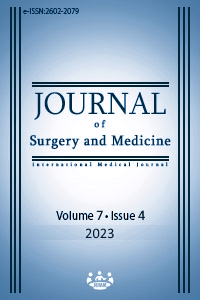A case of spontaneous ovarian malignant neoplasm rupture and life-threatening massive intra-abdominal bleeding
Spontaneous malignant ovarian tumor rupture
Keywords:
hypovolemic shock, ovarian tumor, serous carcinomaAbstract
Although ovarian cancer is the second most common gynecological cancer, it is the most common gynecological malignancy that causes death. Approximately 75% of the patients are diagnosed at an advanced stage, and high-grade serous-type ovarian cancer is detected in most of these patients. The final pathology result in our case was high-grade serous ovarian carcinoma. Our patient, 39 years old, applied to our emergency department with complaints of inability to urinate for three days and new onset abdominal pain. We were consulted because of detection of an 11 cm solid mass and globe vesicle in the pelvic region detected on the computed tomography (CT) taken in the emergency department. The patient's initial hemoglobin value was 11.2 g/dL and the beta-human chorionic gonadotropin (ß-HCG) value was negative. During the follow-up, the patient’s hemoglobin values were 9.2 and then decreased to 8.6, 8.1, and 6.5 g/dL after which hypotensive shock developed in the patient. The patient was taken for an emergency laparotomy. Intra-operatively, 1500 mL of intra-abdominal hemorrhagic fluid and diffuse tumor fragments were observed. In the right adnexal area, approximately 11 cm of ruptured tumor tissue, which may originate from the ovary or uterus, was observed. It was observed that the Douglas pouch and uterine, internal iliac , and some parts of the external iliac arteries were extensively invaded by the tumor and active bleeding occurred. Total Abdominal Hysterectomy + Bilateral Salpingo-Oopherectomy (TAH+BSO) was performed on the patient. Additional surgical intervention could not be performed because the patient had extensive vascular tumor invasion, heavy bleeding, and was in hypotensive shock. Six anti-bleeding sponges were placed on intra-abdominal bleeding areas. In addition, packing was applied to the patient by placing four sterile compresses and soft drains inside the abdomen. Tranexamic acid was administered to the patient, and six units of red blood cell suspension and four units of fresh frozen plasma were transfused. The patient was transferred by ambulance to a higher institution, which is a gynecological oncology center, for follow-up, treatment, and complementary surgery. In this case, we aimed to draw attention to a rare case of ovarian malignancy rupture and hypotensive shock.
Downloads
References
Mohammadi A, Mojtahedzadeh M, Ahmadi A, Imanipour MH, Saghafi F, Soltaninejad S, et al. Bowel Obstruction by Persimmon Phytobezoar. IJMTFM. 2021; 11(3):32507. doi: 10.32598/ijmtfm.v11i3.32507. DOI: https://doi.org/10.32598/ijmtfm.v11i3.32507
Gökbulut V, Kaplan M, Kaçar S, Akdoğan Kayhan M, Coşkun O, Kayaçetin E. Bezoar in upper gastrointestinal endoscopy: A single center experience. Turk J Gastroenterol. 2020 Feb;31(2):85-90. doi: 10.5152/tjg.2020.18890. DOI: https://doi.org/10.5152/tjg.2020.18890
Georgiev YP, Karashmalakov AG, Zafirov GK. Esophageal bezoar after repeated fundoplications. Quant Imaging Med Surg. 2018 Mar;8(2):257-8. doi: 10.21037/qims.2017.06.07. DOI: https://doi.org/10.21037/qims.2017.06.07
Ustaoğlu M, Paköz ZB. Üst Endoskopide Yabancı Cisim Saptanan Hastaların Analizi: Doğu Karadenizde Tek Merkezli Retrospektif Çalışma. Kırıkkale Üniversitesi Tıp Fakültesi Dergisi. 2020;22(1):1-6. doi: 10.24938/kutfd.586116 DOI: https://doi.org/10.24938/kutfd.586116
Altintoprak F, Dikicier E, Deveci U, Cakmak G, Yalkin O, Yucel M, Akbulut G, Dilek ON. Intestinal obstruction due to bezoars: a retrospective clinical study. Eur J Trauma Emerg Surg. 2012 Oct;38(5):569-75. doi: 10.1007/s00068-012-0203-0. DOI: https://doi.org/10.1007/s00068-012-0203-0
Khalil H, Parmar C, Sufi P. Conservative Managing of Bezoar in Giant Hiatus Hernia Causing Gastric Outlet Obstruction During the COVID-19 Pandemic. Obes Surg. 2021 Jun;31(6):2780-2. doi: 10.1007/s11695-021-05250-y. DOI: https://doi.org/10.1007/s11695-021-05250-y
Padhya K, Dhamija A, Carlson C, Farivar A. Post-Fundoplication Esophageal Bezoar Resolved With Endoscopic Instillation and Oral Ingestion of Cola. The American Journal of Gastroenterology. October 2019;114:S1022-3. doi: 10.14309/01.ajg.0000596816.59903.5b. DOI: https://doi.org/10.14309/01.ajg.0000596816.59903.5b
Downloads
- 732 845
Published
Issue
Section
How to Cite
License
Copyright (c) 2023 İsa Kaplan
This work is licensed under a Creative Commons Attribution-NonCommercial-NoDerivatives 4.0 International License.
















